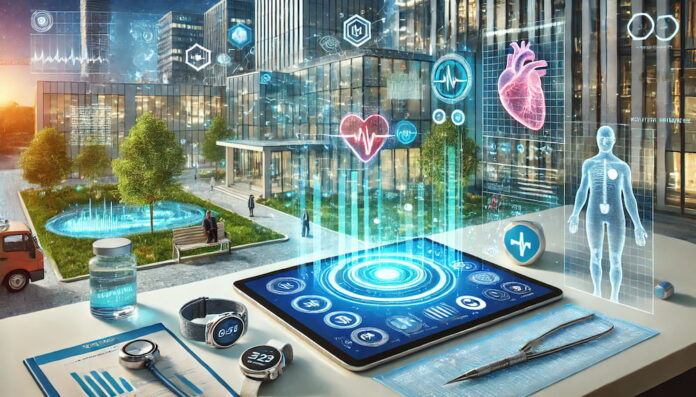The healthcare landscape is undergoing a seismic shift with the advent of digital health technologies. These innovations are not just modern conveniences; they are transformative tools that bridge gaps in accessibility, improve patient outcomes, and empower individuals to take charge of their health. From wearable devices to telehealth and artificial intelligence, digital health is creating a paradigm shift in how care is delivered and experienced.
A New Era of Connectivity in Healthcare
One of the most significant advancements in digital health is the integration of telemedicine. Telehealth platforms have revolutionized how patients interact with healthcare providers, offering virtual consultations that reduce the need for in-person visits. This development proved particularly crucial during the COVID-19 pandemic, as healthcare systems worldwide scrambled to provide safe and accessible care amidst lockdowns and restrictions.
Telemedicine is especially beneficial for managing chronic conditions such as diabetes, hypertension, or asthma. Patients can schedule regular check-ups with their private GP from the comfort of their homes, ensuring continuity of care without logistical hurdles like commuting or taking time off work. These virtual consultations have proven effective in improving patient adherence to treatment plans, ultimately reducing hospital admissions and emergency visits.
Facilities like Spital Clinic have embraced this new reality by offering telehealth options, ensuring that patients have access to trusted medical advice and care, even when they cannot visit in person. While maintaining the personal touch that defines quality healthcare, clinics like these are leading the way in adopting a hybrid model of in-person and digital consultations.
Wearable Technology: Your Health at a Glance
Wearable health devices have become a staple of modern health monitoring, and their role in preventive care cannot be overstated. From smartwatches that track heart rates and sleep patterns to fitness trackers capable of detecting irregular heart rhythms, wearable technology enables real-time health insights for users. These devices empower individuals to take proactive steps toward better health by providing them with actionable data.
For specific patient groups, such as pregnant women, digital health innovations extend even further. Combining wearable technology with ultrasound services allows clinics to monitor fetal wellbeing remotely. Remote monitoring tools, coupled with regular ultrasound check-ups, offer reassurance to expectant mothers while enabling clinicians to detect early signs of complications. This integration of wearable technology with diagnostic tools exemplifies how digital health is enhancing patient experiences in specialized areas of medicine.
AI and Big Data: Predictive and Personalized Medicine
Artificial intelligence (AI) is another revolutionary force in digital health, powering advancements in predictive analytics and personalized care. AI algorithms analyze vast amounts of patient data to identify patterns and trends, enabling clinicians to predict disease risks and tailor interventions. For example, AI can predict the likelihood of a patient developing diabetes or cardiovascular disease based on their medical history and lifestyle factors.
At facilities like Spital Clinic, AI-powered tools are integrated into patient care pathways, helping private GPs determine which patients may benefit from advanced diagnostic imaging, such as targeted ultrasounds. This approach ensures that clinicians have a detailed view of potential health issues, enabling them to make informed decisions that improve patient outcomes.
AI’s role also extends to managing healthcare workflows. By automating routine administrative tasks, AI frees up valuable time for healthcare professionals to focus on patient care. This efficiency not only reduces costs but also enhances the quality of service delivery.
Remote Diagnostics and Digital Therapeutics
Another exciting development in digital health is the rise of remote diagnostics and digital therapeutics. Remote diagnostic tools enable patients to perform basic health checks at home and share the results with their healthcare providers in real time. These tools are particularly valuable in managing conditions like hypertension and diabetes, where continuous monitoring is critical.
Digital therapeutics, on the other hand, use software-based interventions to treat and manage diseases. These applications, often prescribed by healthcare providers, can deliver cognitive-behavioral therapy for mental health conditions or provide structured exercise programs for patients recovering from injuries. Such innovations complement traditional medical treatments, creating a more holistic approach to care.
Challenges in Digital Health Adoption
Despite its promise, digital health faces several challenges that must be addressed for widespread adoption. Data privacy and security are among the top concerns, with stringent regulations such as the General Data Protection Regulation (GDPR) in Europe requiring healthcare providers to implement robust cybersecurity measures. Ensuring the safety and confidentiality of patient data is critical for maintaining trust in digital health systems.
Another challenge is the digital divide. Not all patients have access to smartphones, wearable devices, or stable internet connections, limiting the reach of digital health solutions. Bridging this gap requires targeted efforts to provide affordable technology and improve digital literacy among underserved populations.
The Future of Digital Health
As digital health technologies continue to evolve, their potential to transform healthcare becomes increasingly apparent. From virtual consultations and AI-driven diagnostics to wearable devices and digital therapeutics, these advancements are creating a more connected, efficient, and patient-centered healthcare system.
Facilities that embrace these innovations, such as those offering private GP and ultrasound services, are at the forefront of this revolution. By combining cutting-edge technology with compassionate care, clinics like Spital Clinic are ensuring that patients receive the best of both worlds—advanced medical expertise and a personalized approach to health.
The journey toward a fully digital healthcare ecosystem is still underway, but the progress made so far demonstrates the immense potential of these technologies. By addressing the challenges and harnessing the power of innovation, the future of healthcare looks brighter than ever.
Did you find this helpful? Check out our other helpful articles on our website.
Read Also
- Why the Keto Diet Works for Some People—and Fails Dramatically for Others: An Ayurvedic Breakdown for Modern HealthcareThe keto diet has dominated weight-loss culture for years. For some people, it produces rapid fat loss, stable energy, and improved mental clarity. For others—especially those who gain weight easily—it leads to burnout, digestive distress, rebound weight gain, high cholesterol, and a metabolism that feels slower than before. Healthcare often frames this as a discipline… Read more: Why the Keto Diet Works for Some People—and Fails Dramatically for Others: An Ayurvedic Breakdown for Modern Healthcare
- How to Choose the Best Assisted Living Facility for SeniorsAre you looking for the right assisted living facility for a senior loved one? Choosing a place can feel overwhelming. There are many factors to consider, from care services to the environment. Safety, comfort, and social opportunities play important roles in daily life. Each senior has unique needs and preferences that must be met. Understanding… Read more: How to Choose the Best Assisted Living Facility for Seniors
- Burn Smart, Not Hard; Shape Burn: Clean Protein for Weight ManagementYou want to feel light, strong, and confident. You don’t want crash diets or fake promises. You need a plan that works with your body, not against it. That’s where Shape Burn comes in. You can burn fat without losing strength. You can eat better and stay full. You can manage weight in a way… Read more: Burn Smart, Not Hard; Shape Burn: Clean Protein for Weight Management
- Creatine Basics: How Much Is 5g, How Much Water You Need, and Whether Pills or Powder Work BetterIf you’ve ever walked into a supplement aisle or scrolled through fitness TikTok, you’ve probably seen people talking about creatine — usually with a shaker bottle in hand and promises of better workouts and faster gains. And honestly? They’re not wrong. Creatine is one of the most researched and effective supplements for muscle strength, recovery,… Read more: Creatine Basics: How Much Is 5g, How Much Water You Need, and Whether Pills or Powder Work Better
- Understanding Breast Cancer in Men: Key Facts and SymptomsBreast cancer is often thought of as a disease that only affects women. However, men can develop it too. Although it is less common, early detection and awareness are important. Read on to learn key facts, symptoms, and ways men can take action to protect their health. How Common Is Breast Cancer in Men? Breast… Read more: Understanding Breast Cancer in Men: Key Facts and Symptoms
- Raising Awareness: Breast Cancer Facts for Older MenBreast cancer does not affect only women, and many older men do not realize they are at risk. Because the signs can be easy to miss, many men learn about the disease only when it has progressed. Learning the basic facts now can help you stay aware and respond early. If you want to protect… Read more: Raising Awareness: Breast Cancer Facts for Older Men
- How Regular Exercise Transforms Senior Living for the BetterGetting older is something everyone experiences, but how we age can be greatly influenced by the choices we make. One of the best ways for seniors to stay healthy, happy, and independent is through regular exercise. Staying active isn’t just about fitness-it can improve nearly every part of life. From building strength and energy to… Read more: How Regular Exercise Transforms Senior Living for the Better
- The Importance of Mammograms and Early Detection for Aging WomenAs women age, taking care of their health becomes even more important. One key part of women’s health is regular breast screenings. Mammograms are a simple but powerful tool that can detect breast changes early. Early detection can save lives by finding problems before they become serious. For aging women, staying informed and proactive about… Read more: The Importance of Mammograms and Early Detection for Aging Women









